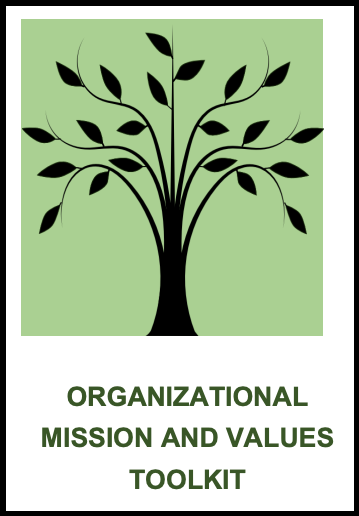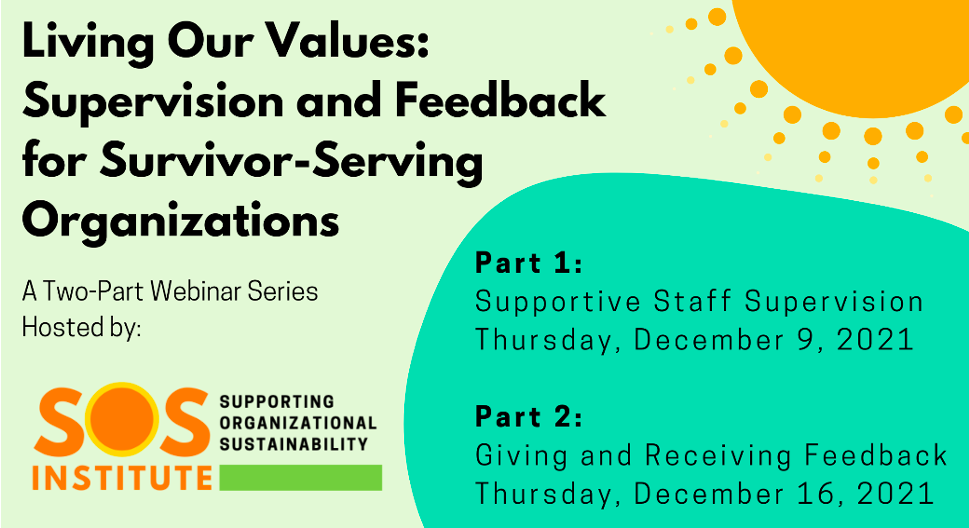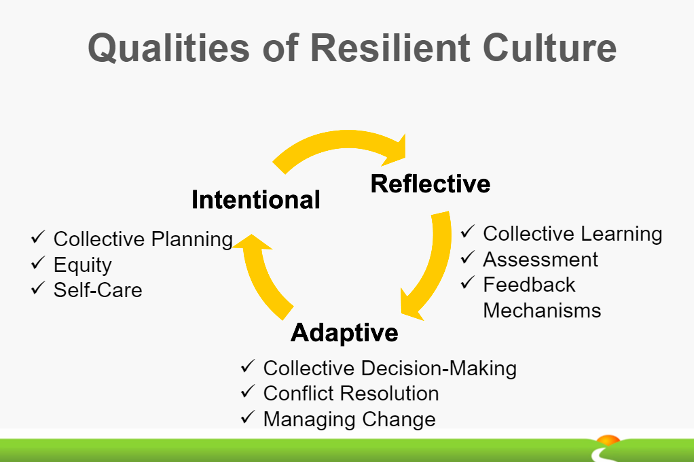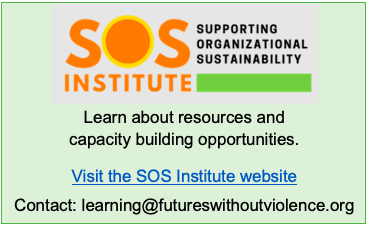By Abby Larson, Program Manager, and Mónica Arenas, Program Manager with Futures Without Violence
The gender-based violence field exists to challenge systems of oppression that create a culture where interpersonal violence is normalized and accepted. As a field, we understand that power dynamics are multi-dimensional and seep into almost every aspect of our personal and professional lives. We strive to prevent violence before it happens by changing cultural norms and showing up for survivors of violence with unwavering and nonjudgmental support. We try to meet people where they are without leaving them there. We spend a lot of time and energy making sure our services do not reproduce the violent environment that leads survivors to us in the first place. We seek to create well-being and workplace conditions that help advocates stay employed, healthy and safe. We have made many mistakes along the way. Mainstream organizations, in particular, have had to reckon with a history of catering primarily to the needs of straight white women. At the same time, Black, Indigenous, People of Color (BIPOC) led organizations and other advocates of color have continued to push this work forward by prioritizing critical intersections, like health equity and the importance of centering Black women.
So how do we take these lessons, values, and commitment to change how power operates in our relationships and apply them to our organizational structures?
Many of us are survivors ourselves, and to sustain this work as an inclusive, anti-oppressive, trauma-informed, and transformative movement, we need to build organizations that reflect these needs. We can do this by creating opportunities and resources that support staff wellbeing and healing in the workplace. Sustainability in this movement means turning our convictions inward and modeling what we aim to see in the outside world through our organizational culture and infrastructure. Some ways we can do that include:
- Grounding the work in core values connected to the overall mission, vision, and day-to-day;
- Transforming leadership by acknowledging and reducing power dynamics in supervisory relationships and management structures;
- Building organizational resilience by assuming responsibility for supporting staff in their roles and developing their strengths; and
- Recruiting and engaging a board of directors that represents and is deeply invested in the communities we serve.
The strategies listed below are a few examples of ways gender-based violence organizations have put their values into action:
1. Connecting to Core Values
- The organization develops core values collaboratively with a shared sense of deeply held beliefs that provide guidance and ground the organization. They are accessible, clear, and serve as a touchstone for strategic planning, decision-making, organizational policy development, implementation, and day-to-day relationships.
- The core value development process is responsive to communities served by the organization and centered on prioritizing the needs of historically marginalized and targeted communities and stakeholders. A values statement can support and advance a culture of equity and racial justice. Anti-violence work requires an intersectional lens rooted in justice and dismantling all systems of oppression. There is no single-issue anti-violence cause.
“There is no such thing as a single-issue struggle because we do not live single-issue lives.” ― Audre Lorde
- Staff feedback is connected to and rooted in core values rather than individual preferences and traditions. This shapes the organization’s culture to be open to change and grounded in the mission and vision.
- Hire staff and bring on new board members with lived experience and demonstrated mission and values alignment. Maintaining an organizational culture rooted in its core values requires buy-in and commitment from everyone, especially people in positions of power.

- The board of directors and leadership staff are responsible for modeling and operationalizing core values. It should not be up to staff with the least positional power to regularly advocate for weaving core values into the organization’s culture and operations.
Resource: Mission and Core Values Toolkit includes activities and resources to help your organization examine your mission and core values. Core Values Webinar.
2. Transformative Leadership
- The goals of staff supervision are to “increase self-awareness, teach skills, offer motivation, navigate challenges, and support resilience, while addressing trauma as it arises in the work – avoiding both re-traumatization and revictimization.” (Cathy Cave and Michael Johnan)
- Supervisors are not therapists or parental figures. Their role is to support staff accessing internal systems in the organization and to support and motivate their growth and development in their role.
- This requires communicating clear expectations that do not rely on the supervisor's preferences or the way things have always been done (i.e., traditions) in the organization. Staff and supervisors work together to build on strengths and explore options for meeting the role's requirements.
- Supervisors are transparent and share with the staff they supervise about new approaches they are trying and personal areas of growth.
- One-on-one check-ins are scheduled regularly and leave time for reflection and problem-solving. Thought partnership, accountability, and trust are the basis of supervisory relationships.
- Holding staff accountable requires leaders to be accountable, seeking and accepting feedback, and a willingness to accept responsibility for mishaps and mistakes. At the same time, repairing those mistakes and using the experience to make changes.
- Staff and supervisors have explicit conversations about the power dynamics in their relationship and the complexity of navigating their intersectional identities in relation to the work. This is not a one-time conversation; it happens regularly and with applied context based on a given situation.
- Organizations and their leaders need to cultivate an ongoing learning environment that supports staff development, offers inspiration that is mission focused, and provides or connects to mentoring or coaching opportunities.

Resource: This recorded webinar series on supervision and feedback styles includes tools and resources to build trust in supervisory relationships.
3. Organizational Resiliency
- Personal interactions and the overall environment are key to developing and sustaining resilience. Both leaders and the infrastructure of the organization play a role in building resiliency.
- The organization assumes responsibility for caring for staff and does not leave it up to individuals to advocate for their needs. Examples include offering flexible and generous paid time off (PTO) for rest, vacations, mental health, caregiver leave, and time to give back to the community outside of work.
- Create a generative feedback culture where staff at all levels are encouraged to share positive and constructive feedback. A feedback culture is not “top-down,” and involves staff at all levels in decision-making processes.
- Gretta Gardner, Deputy Director for Ujima Inc. and a faculty presenter in the Supporting Organizational Sustainability (SOS) Institute webinar below, stresses the importance of balancing communication during times of stress and change. With COVID as an example, over-communication can increase staff stress levels and lead to confusion and burnout. Clearly communicate essential information and use boundaries and balance to prevent information overload.
- The Orange County Rape Crisis Center’s policy on addressing conflict touches on the importance of feedback for initiating organizational change and staff wellness. Executive Director and SOS Institute faculty, Rachel Valentine, describes her agency’s outlook in this way: “It’s either important enough that you need to talk about it with people who have the power to fix it, or it’s not and you need to learn how to forgive and move forward. But holding on to something that is important robs you of your peace and it robs us as an organization of the opportunity to make needed changes.”

Resource: Organizational Resiliency in Managing Challenges (webinar recording with resources).
4. Engaged and Intersectional Board of Directors
- The board of directors plays an important role in organizational development and sustainability. Recruiting a diversity of experience and representation of communities served is an essential first step. However, there must be systems, policies, and a board culture that affirms new board members as changemakers with a valued voice, not tokens.
- Create an onboarding plan for new members by pairing them with experienced members or staff who can introduce them to the organization. This “buddy” can share relevant information about core values, processes, and other systems of support in place.
- Engage new and existing board members with regular capacity building opportunities, including emerging issues in the field, ongoing power analysis, clearly defined board roles, and the board’s role in advancing equitable organizational infrastructure.
- “AAA” Boards can be Ambassadors to the community, Advocates for the organization, and Askers for financial support. Understanding the importance of these roles can help align board recruitment, policies, and staff relationships with the organization’s mission and values.
- Reconsider minimum annual donation requirements and requiring 100% board giving. These policies prevent people from joining the board who do not have the financial means to make a personal donation. There are many other important contributions board members can make that are values-aligned, like lived experience, and connections to the communities served.
Webinar and Resources: Developing an Engaged Board of Directors to Advance Equity
Supporting organizational sustainability involves building a resilient culture where staff are engaged in collective learning, decision-making, and planning. It also includes strategies for communication, conflict resolution, and managing change and transition. Building resiliency means creating organizational structures for cross training, workload assessments, transparent and trauma-informed evaluations, and feedback mechanisms that consider equity values. These efforts can improve staff resiliency and also benefit services for survivors and the community.
We invite you to examine the strategies highlighted above and explore practices that could be implemented in your organization and those that you can apply personally. Advocate for change, collaborate and work in teams to enhance structures and policies that are aligned with your mission and core values. Utilize and share the resources included and engage in capacity building.
Additional Resources:
- Ten Strategies to Enhance Employee Resilience and Engagement Within Survivor-Serving Organizations
- Providing Support Through Organizational Transitions (Webinar and Toolkit)
- Mini Strategic Planning Process Toolkit
About the Supporting Organizational Sustainability (SOS) Institute and Resources
















